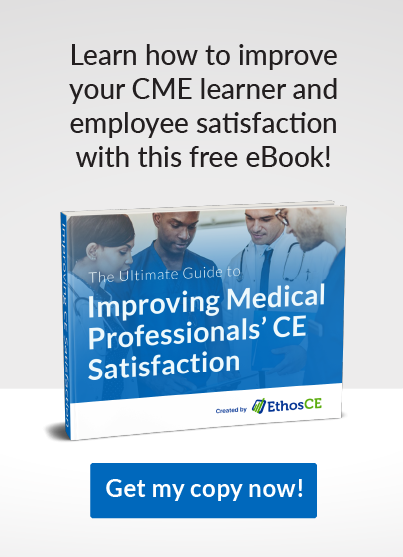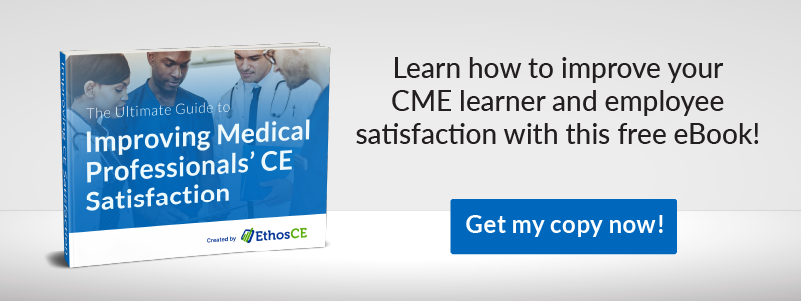How to Rethink CE for Healthcare Professionals
When you’re caught up in the day-to-day administration of your CE program for healthcare professionals, it’s hard to step back and consider improvements that you can make in your course outlines or content. EthosCE allows you to automate many of your duties, freeing you to develop new solutions to strengthen the content and outcomes of your CE program.
We’ve put together a list of a few ways you can rethink your CE program for healthcare professionals. Improving learning outcomes involves more than achieving improved course completion rates or creating new basic content. Lifelong learning in adults comes from engagement, and your learners need social experiences and the opportunity to solve problems in addition to strong CE course content.
Develop active learning experiences
How can you turn your courses from passive information transfer and test-taking into active learning experiences? For years, education research has shown that adult learners respond more positively to active, self-directed learning opportunities than to passive learning.
Active learning opportunities develop critical thinking and analysis skills. To include more active learning strategies in your CE for healthcare professionals, it helps to first understand the difference between passive and active learning.
Traditional lectures, readings, and quizzes are passive learning and the work that everyone expects to do in continuing education. However, engagement is much higher when learners are asked to take responsibility, collaborate, or engage in self-directed learning.
If you’re delivering in-person CE courses, you can use techniques like “think-pair-share” to strengthen engagement. For example, in a simple CE course for nurses on tick-borne diseases, the instructor could assign pairs to independently research one tick-borne disease and present methods to recognize, diagnose, and treat their assigned disease. Think-pair-share is also easy to adapt to online CE courses, with the use of message boards and assigned peer learning groups.
Add social content: EthosCE makes this easy and intuitive
EthosCE supports the sharing of audio and video content via webcasts, etc. Combined with discussion boards and email contact, you can develop an entire social learning environment for your CE courses. Discussion boards can support peer-learning activities.
Sharing your content online can support enrollment growth and retention. Use a public portion of a course to encourage enrollment and ongoing engagement. EthosCE’s add-ons easily allow you to turn lectures into e-learning activities.
Develop improved course outcomes and ways to measure them
EthosCE’s LMS supports the development and monitoring of measurable and attainable online course outcomes with its built-in reporting system. Whether you’re tracking course progress or learner engagement, EthosCE’s built-in reporting system allows you to quickly and easily determine which learners are engaged and progressing and which ones may be falling behind or bored.
You can identify specific outcomes in the form of engagement with course material, project, or collaborative assignment completion or traditional assessment tools like quizzes and tests.
Other ways to rethink CE for healthcare professionals
Peer-to-Peer Learning and Problem-Solving
Learning depth and retention improves dramatically when adult learners work together to solve problems. The variety of issues that you can offer to your healthcare CE learners is limitless. For example, a CE course in outreach to underserved populations could assign class members to locate health promotion materials in their organizations. Class members could review the materials for their cultural competency and effectiveness according to guidelines presented in the course. A course capstone might be the design of new and more effective and culturally responsive health promotion materials for diverse audiences.
Lecture-Plus
Research shows that learners of any age, including adults, can’t absorb more than ten minutes of lecture. Break lectures up into bite-sized, manageable parts. Have an activity or mini-quiz to increase learning and retention after five- to ten-minute segments.
Increased Collaboration
Healthcare professionals collaborate on the job all day long. Yet certain CE courses haven’t changed for years. They may be offered in an online format but still include traditional lectures, readings, quizzes, and tests. Adult learners enjoy challenges and working with others to solve problems. With some creativity, you can step back and rethink your courses. It isn’t easy or simple to revitalize CE programs for healthcare professionals, but the outcome will be rewarding for your learners and your organization.
Let EthosCE handle administration while you get creative
EthosCE supports your work in-person and online. You can automate many tasks, including attendance, certification, and payment. This allows you to spend your time developing revitalized courses with engaging content and active learning opportunities. The rewards will show in terms of increased engagement, repeat enrollments, and rave reviews. Developing active, creative assignments takes time, but once you get the hang of how to engage adult learners, it will make your job easier and more rewarding.
EthosCE believes CME technology solutions should be designed to improve healthcare professionals’ user experience, comply with ACCME guidelines, reduce administrative costs, and demonstrate measurable outcomes.
To learn how EthosCE can enhance the continuing education of your medical professionals, request a free 1-on-1 demo with one of our specialists today!
 We're now part of the Cadmium product suite! Learn more
We're now part of the Cadmium product suite! Learn more 


